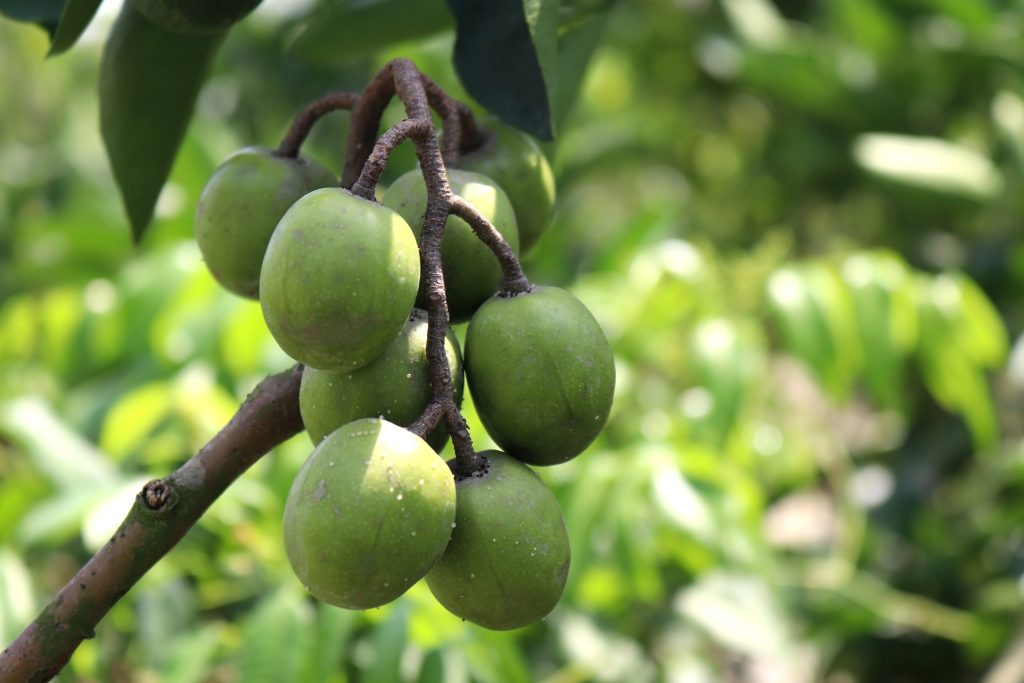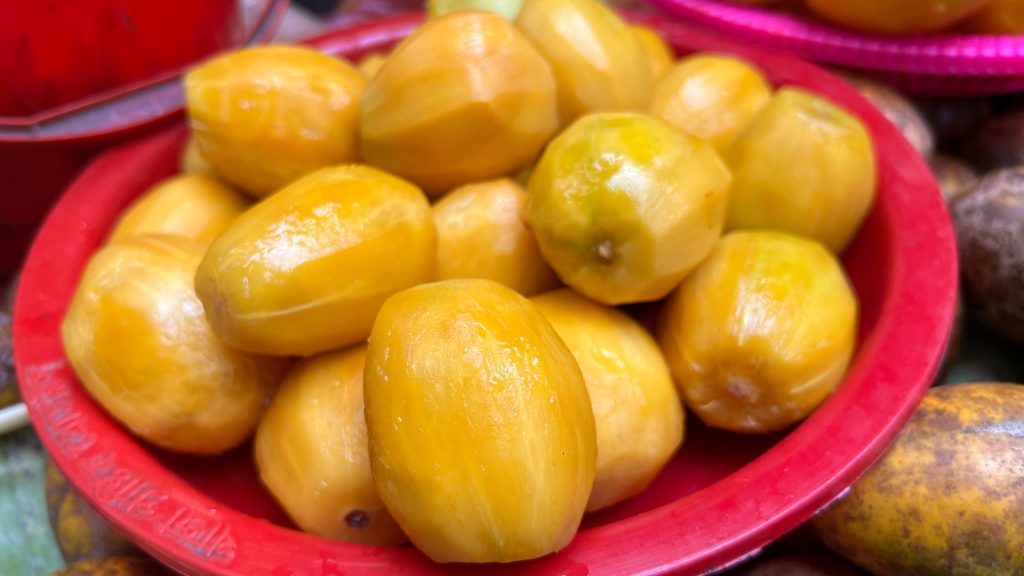Hog plums are a fruit native to parts of Africa and Southeast Asia. They are known for their sweet and tangy flavor and are often used in various culinary dishes. Hog plums are also rich in vitamin C, iron, and potassium, making them a popular choice for health-conscious individuals.
Table of Contents
What is a Hog Plum?
The hog plum (Spondias mombin) is a tropical fruit tree native to Central and South America and parts of the Caribbean. You can see it in areas like Brazil, Paraguay, and Uruguay.
Hog plum belongs to the Anacardiaceae family, including cashew, mango, and pistachio.
The fruit of the hog plum tree resembles a June plum, and it is a small, oval-shaped drupe with a thin, edible skin that ranges from green to yellow when ripe. The flesh is juicy and yellow, with a large, inedible seed in the center. The flavor of hog plum is often described as tart, tangy, and slightly sweet, with a subtle tropical taste.
Hog plum is also known by several other common names, including yellow mombin, Spanish plum, Jocote de Corona, ciruela, and jobo. It is a popular ingredient in traditional dishes and beverages in some regions.
In Jamaica, the fruit is used to make a refreshing drink called “hog plum juice,” which is made by boiling the fruit in water with sugar and spices. The plant (especially the young leaves) is also used by traditional medicine to treat rheumatism, pain, digestive problems, sore throat, malarial fever, urethritis, gonorrhea, stomach pain, and diarrhea – to name a few.
The History of Hog Plums
The history of hog plum will take us from the tropical Americas to Asia and Africa. The story begins with the hog plum’s first encounter with European settlers, who were drawn to the fruit’s bright and vibrant colors.
The Spanish and Portuguese were so enamored with the hog plum that they took it with them on their travels worldwide. Fast forward to the 17th century, when the Portuguese finally introduced the hog plum to Asia. The fruit quickly found a home in the tropical climate, where it thrived and became naturalized.
In Mexico, the fruit is pickled in vinegar and eaten with chili and salt, creating an irresistible combination of tartness, spiciness, and bitterness to make your taste buds dance with joy.
The hog plum is a source of many valuable offerings, but did you know the tree has a lot of other unknown uses? Its gum can be used as glue, while its bark is used for tanning and dyeing. And if you’re feeling creative, you can make small trinkets like cigarette holders and amulets out of the tree’s thick bark.

What Does a Hog Plum Taste Like?
When raw, hog plum has a tangy, acidic flavor with a slight sweetness. The flesh is crunchy and juicy with a fibrous texture. Some people describe the taste as a cross between a green mango and a pineapple.
When cooked, hog plum can be used in various dishes, including curries, chutneys, and jams. The flavor becomes more mellow and sweet, and the texture softens. It is often used as a souring agent in dishes, similar to tamarind or lime.
How to Tell When Hog Plum is Ripe
When it comes to determining whether hog plums are ripe, there are a few critical visual characteristics to look for:
| Color | Hog plums start green and gradually turn yellow as they ripen. When fully ripe, the fruit will have a deep yellow or orange color. |
| Texture | Ripe hog plums will feel slightly soft to the touch but not mushy. The skin may also be somewhat wrinkled. |
| Firmness | When gently squeezed, a ripe hog plum should give slightly, indicating that the flesh inside is soft and juicy. |
| Scent | Ripe hog plums will have a strong, sweet aroma that is easily detectable. |
Cooking with Hog Plums
Let’s dive into the world of hog plums and discover how to incorporate them into our cooking creatively.
Preparing Hog Plums:
- Start by washing the fruit under cold water.
- Cut the fruit in half lengthwise and remove the large seed in the center.
- Depending on the recipe, the fruit can then be cut into thin slices, cubed, or chopped.

Hog plums can be used in various sweet and savory dishes and are particularly popular in Caribbean and Southeast Asian cuisines. Here are a few examples:
Hog Plum Curry: This is tantalizing tango of tangy hog plums bathed in a rich, aromatic curry. It’s the perfect fusion of spicy and sour, and it will keep you guessing with each bite!
Hog Plum Chutney: This is not just a chutney but the perfect accompaniment to any meal, boldly elevating the flavors of your dish with a zesty punch. It’s sweet, tangy, and never dull!
Hog Plum Pickle: This is a rollercoaster ride of flavors, with the hog plum’s tanginess playfully clashing and then reconciling with the spices.
Amtekai Gojju (Menaskai) | Indian Hog Plum Curry: This is where the traditional Indian cuisine meets the audacious hog plum in a burst of flavors. Each spoonful of this curry is like a mini journey through the streets of India, with the hog plum’s tangy notes cutting through the rich cream.
How to Store Hog Plums
Depending on their ripeness, hog plums can be stored in a cool, dry place for a few days to a week.
However, if you want to extend their shelf life, keep them in the refrigerator for up to 2 weeks. To store hog plums in the fridge, seal them in a plastic or paper bag. Make sure to check them regularly and discard any that are bruised or moldy.
If you want to store hog plums for over two weeks, you can freeze them. To freeze hog plums, wash and dry them thoroughly, remove the seeds, and slice them into pieces. Place the slices in a freezer-safe container or bag and freeze them for up to 6 months.
Nutritional Benefits of Hog Plums
Hog plums contain vitamins, minerals, and phytochemicals that perform oxidation functions in the body system. Its rich content of antioxidants helps reduce the effects of oxidative stress caused by free radicals in the body.
Here are some other ways hog plums can benefit your health:
- Hog plums are rich in dietary fiber, which helps maintain a healthy digestive system.
- Hog plums are a good source of iron, which helps produce hemoglobin and myoglobin. Hemoglobin and myoglobin transfer oxygen throughout the body systems, and iron is essential to prevent anemia and other blood conditions.
- Hog plums are rich in vitamin C, an antioxidant that inhibits harmful oxidation processes by free radicals in the body.
- Hog plums are a good source of vitamin K, which helps maintain proper bone health and aids in blood clotting and bone strengthening.
- Lastly, Hog plums contain thiamine, which helps in muscle contraction and conduction of nerve signals.
Where to Purchase Hog Plums
One of the best places to look for hog plums is at your local Latin American or Caribbean grocery store or market. You can also look for specialty stores that specialize in tropical fruits.
In addition to specialty stores, you may find hog plums at farmers’ markets during the peak growing season. The best time to find hog plums is during the summer months when they are in season. You can also find them at larger supermarkets and grocery stores during this time.
If you are unable to find fresh hog plums, you may also be able to find them in the form of jams, jellies, or preserves at specialty stores or online. Some online retailers specialize in exotic fruits and may carry hog plums.

